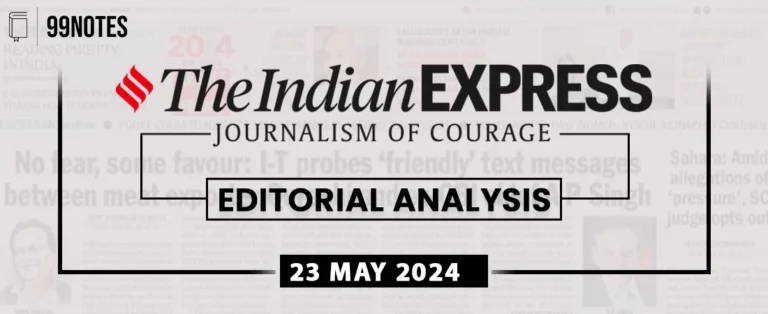23 April 2024 : Indian Express Editorial Analysis
Indian Express Editorial Analysis
23-April-2024
1. The cost of health
| Topic: GS2 – Governance – Government policies – Issues arising out of their design & implementation
This topic is relevant for both Prelims and Mains as the analysis delves into the role of the judiciary, specifically the Supreme Court, in addressing societal issues such as healthcare accessibility and affordability. |
| Context: |
|
The Supreme Court’s Intervention:
- The recent pronouncement by the Supreme Court of India regarding healthcare costs reflects a significant judicial response to the pervasive issue of medical expenses.
- The Court’s stance, triggered by a public interest litigation (PIL) urging for standardized charges under the Clinical Establishment Act, signifies a pivotal moment in the discourse on healthcare affordability.
- By threatening to enforce Central Government Health Scheme (CGHS) rates, the Court aims to confront the mounting burden of healthcare costs faced by patients and their families.
Challenges and Opportunities:
- However, the Court’s intervention raises pertinent questions regarding its effectiveness in a domain traditionally governed by governmental policies.
- Can judicial directives effectively fill the void left by governmental inaction? What complexities does the Court navigate in wading into the realm of healthcare economics.
The Imperative of Universal Healthcare:
- At the heart of this debate lies the imperative of universal healthcare, a policy prescription resonating globally as a means to ensure equitable access to medical services.
- The concept advocates for publicly funded healthcare systems, thereby eliminating financial barriers to treatment based on social class or economic status.
- Through taxation, such systems redistribute the costs of healthcare, ensuring that the affluent subsidize the medical needs of the less privileged.
The Evolution of India’s Healthcare Landscape:
- Tracing India’s journey in healthcare provision reveals a trajectory marked by a shift towards privatization, driven by a combination of neglectful state policies and the emergence of a lucrative private healthcare sector.
- Post-independence aspirations for universal healthcare gradually gave way to the proliferation of private hospitals catering to the needs of the elite.
- This privatization trend accelerated post-liberalization, with for-profit hospital chains capitalizing on global investments and technological advancements.
Challenges of Private Healthcare in India:
- Private healthcare in India, characterized by a lack of regulation and a profit-driven ethos, poses formidable challenges to equitable healthcare delivery.
- The absence of oversight allows for irrational treatments and financial exploitation, exacerbating the plight of patients.
- Moreover, the co-option of medical professionals into profit-oriented practices creates inherent conflicts of interest, compromising the integrity of care delivery.
Governmental Response and Policy Dilemmas:
- Faced with the daunting task of addressing healthcare disparities, successive governments in India have adopted a patchwork approach, oscillating between efforts to revitalize public healthcare infrastructure and resorting to mass insurance schemes for the economically marginalized.
- The introduction of the Clinical Establishment Act in 2010 aimed to bring order to the chaotic healthcare landscape, yet encountered resistance from state governments and industry stakeholders.
The Role of the Supreme Court: A Critical Juncture
- As the Supreme Court steps into the fray, its intervention signifies a critical juncture in the quest for affordable healthcare.
- Yet, the Court’s efficacy in tackling entrenched interests and systemic deficiencies remains uncertain.
- While capping costs may offer temporary relief, addressing fundamental issues of state investment in healthcare infrastructure requires broader systemic reforms.
Conclusion:
- Amidst the cacophony of electoral politics, the imperative of healthcare reform risks being overshadowed by more immediate concerns.
- However, the plight of millions grappling with inadequate healthcare demands urgent attention.
- As the nation stands at the crossroads of governance, the burden on the judiciary to address systemic inequities in healthcare provision looms large, underscoring the imperative of political will in effecting lasting change.
| Challenges Related to Right to Health in India |
Inadequate Healthcare Infrastructure:
|
| PYQ: “Besides being a moral imperative of a Welfare State, primary health structure is a necessary precondition for sustainable development.” Analyse. (150 words/10m) (UPSC CSE (M) GS-2 2021) |
| Practice Question: Discuss the challenges faced by individuals in accessing affordable healthcare in India. How can the government and other stakeholders address these challenges to ensure healthcare affordability for all citizens? (250 words/15 m) |
2. PAYING THEIR FAIR SHARE
| Topic: GS2 – International Relations – Bilateral Relations
This topic is relevant for both Prelims and Mains as the analysis explores the dynamics of international agreements and their influence on bilateral relations between countries. It provides insights into how nations negotiate treaties to attract investments and protect their tax interests, reflecting broader diplomatic and economic strategies. |
| Context: |
|
Evolution of Legal Frameworks: From Treaty Shopping to BEPS:
- Over the past two decades, the landscape of tax treaties has undergone significant transformations.
- Initiatives like the Base Erosion and Profit Shifting (BEPS) program aimed to curb tax avoidance through low-tax jurisdictions, prompting the OECD to develop best practices.
- The introduction of the Multilateral Instrument (MLI) allowed countries to swiftly amend treaties and provisions, garnering wide support.
Reforms Introduced by the MLI:
- One of the key reforms initiated by the MLI was the inclusion of a provision for the prevention of treaty abuse, along with amendments to treaty preambles.
- These changes aimed to prevent tax evasion, including treaty-shopping arrangements, and introduced anti-abuse rules to deny treaty benefits in certain circumstances.
- More than 1,100 treaties now incorporate broad anti-avoidance rules or principal purpose tests (PPTs).
Impact of Amendments to India-Mauritius Treaty:
- Recent amendments to the India-Mauritius treaty signal India’s commitment to closing tax loopholes.
- The amended protocol seeks to deny treaty benefits when obtaining them is one of the principal purposes of a transaction.
- This move addresses concerns about taxpayers routing investments through Mauritius and ensures that tax administrations can probe transactions based on intent.
Challenges and Implications:
- Courts often grapple with determining whether a tax residence certificate is sufficient to grant treaty benefits.
- Legal changes are necessary to assess the purpose of a transaction comprehensively.
- With 16% of FDI inflows originating from Mauritius, reforms to the treaty will impact investment flows, as observed after previous amendments in 2017.
Looking Ahead: The Global Minimum Tax and Policy Shifts:
- The global minimum tax proposal, including the subject-to-tax rule (STTR), signifies a broader shift in international tax law.
- STTR aims to tax low-tax intra-group transactions, potentially altering current practices of treaty utilization.
- As India revises its tax treaties, these amendments demonstrate the evolving landscape of tax policy, emphasizing the broader considerations beyond tax in investment decisions.
Conclusion:
- Tax treaties play a pivotal role in shaping cross-border investments, reflecting evolving legal frameworks and policy objectives.
- The recent amendments to the India-Mauritius treaty underscore India’s commitment to closing tax loopholes and ensuring fair taxation.
- As international tax law undergoes significant changes, the focus shifts towards broader policy considerations, highlighting the need for balanced and equitable tax regimes.
| About DTAA Between India and Mauritius |
About:
|
| Practice Question: Explain the significance of tax treaties in international relations and their impact on India’s economy. Discuss recent reforms aimed at preventing tax avoidance and treaty abuse, and evaluate their effectiveness in ensuring fair taxation and promoting economic development. (250 words/15 m) |
For Enquiry

23 April 2024 : Indian Express Editorial Analysis

Best 10 IAS Coaching in Old Rajinder Nagar

22 April 2024 : Daily Current Affairs Quiz

22 April 2024 : Daily Answer Writing

22 April 2024 : The Hindu Editorial Notes PDF

22 April 2024 : Daily Current Affairs

22 April 2024 : PIB Summary for UPSC Copy

22 April 2024 : Indian Express Editorial Analysis

20 April 2024 : Daily Current Affairs Quiz

20 April 2024 : Daily Answer Writing
April 2024 Indian Express 23 April 2024 : Indian Express Editorial Analysis Indian Express Editorial Analysis
23-April-2024
1. PRESIDENT OF INDIA PRESENTS PADMA AWARDS 2024
Topic:…
Blogs Upsc Best 10 IAS Coaching in Old Rajinder Nagar IAS Coaching in Old Rajinder Nagar: The choice of the IAS coaching institute is very crucial in the…
Daily Quiz 22 April 2024 : Daily Current Affairs Quiz 22- April 2024 : Daily Quiz…
mains answer writing 22 April 2024 : Daily Answer Writing Mains Answer Writing
22-April-2024
Q1) The Green Revolution, with its focus on land productivity, created…
April 2024 The Hindu Editorial 22 April 2024 : The Hindu Editorial Notes PDF The Hindu EDITORIAL
22-April-2024
1. Preparing India for water stress, climate resilience
Topic:…
April 2024 Daily Current Affairs 22 April 2024 : Daily Current Affairs Daily Current Affairs
22-April -2024- Top News of the Day
1. Global Coral Bleaching Crisis: Urgent Action…
April 2024 PIB 22 April 2024 : PIB Summary for UPSC Copy PIB Summary for UPSC
22-April-2024
1. PM inaugurates 2550th Bhagwan Mahaveer Nirvan Mahotsav on occasion…
April 2024 Indian Express 22 April 2024 : Indian Express Editorial Analysis Indian Express Editorial Analysis
22-April-2024
1. Cures, care, competition
Topic: GS2 – Governance…
Daily Quiz 20 April 2024 : Daily Current Affairs Quiz 20- April 2024 : Daily Quiz…
mains answer writing 20 April 2024 : Daily Answer Writing Mains Answer Writing
20-April-2024
Q1) Assess the present computational methodology for Gross Domestic…






